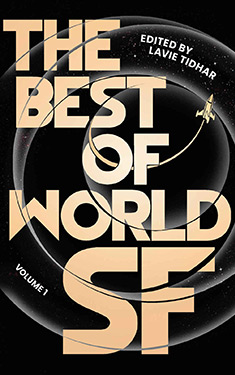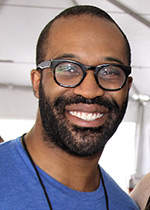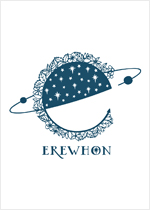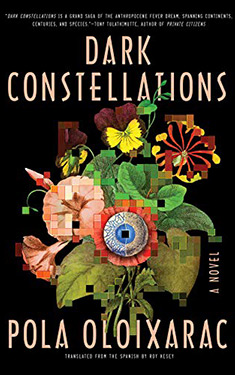Dark Constellations
| Author: | Pola Oloixarac |
| Publisher: |
Soho Press, 2019 Original Spanish publication, 2015 |
| Series: | |
|
This book does not appear to be part of a series. If this is incorrect, and you know the name of the series to which it belongs, please let us know. |
|
| Book Type: | Novel |
| Genre: | Science-Fiction |
| Sub-Genre Tags: | |
| Awards: | |
| Lists: | |
| Links: |
|
| Avg Member Rating: |
|
|
|
|
Synopsis
Canary Islands, 1882: Caught in the 19th-century mania for scientific classification, explorer and plant biologist Niklas Bruun researches Crissia pallida, a species alleged to have hallucinogenic qualities capable of eliminating the psychic limits between one human mind and another.
Buenos Aires, 1983: Born to a white Argentinian anthropologist and a black Brazilian engineer, Cassio comes of age with the Internet and becomes a prominent hacker, riding the wave of transformations brought about by distributed networks, mass surveillance, and new flows of globalized capital.
The southern Argentinian techno-hub of Bariloche, 2024: A research group works on a project that will allow the Ministry of Genetics to track every movement of the country's citizens without their knowledge or consent, using sensors that identify DNA at a distance. But the new technology contains within it the seeds of a far more radical transformation of human life and civilization.
Excerpt
On the final day of 1882, a group of explorers reached the sea that surrounds the crater of Famara, the volcanic mass that rises up from the archipelago of Juba. Like a fortress on the water, the crater's aerial line shrouded the bay in grandeur. The travelers made land on a beach of black sand scored by the tails of lizards, and began their climb along a mossy trail through a series of gorges that wound their way through the sinuous formations of dark lava. Anchored in the bay, their ship looked like an old dinosaur, its viscera extracted by parasites who lowered the cages, bronze instruments, wooden traps and coils of rope into the sand amidst the boulders onshore.
The explorers advanced into the cold, humid scrub growing beneath trees that intertwined high above; from time to time the sky opened in a gleam of white. They walked for hours toward the valleys of the island's interior, across an expansive void of human trace. The island, though submerged in the sand-specked mist that came from the Sahara, was thick with Crissia pallida, the spidery green flowers with nuclei of gold pollen whose extraordinary properties would remain all but unknown until the beginning of the twenty-first century.
The story of these visitors is woven into the belief system of the Guanche religion of Mahan. It is said that as night fell, the foreigners entered the island's deep valleys, still guided by what they took for faint stars, but what they thought was the vault of the sky had become the roof of a cave thick with insects. (They would later swear they'd seen the inverted face of Auriga, the constellation over Orion, blurred by the mist.) As a result of this misperception, Zacharias Loyd, the captain of the expedition, didn't give the order to stop for rest until, all but dead, they'd finally reached mineral soil; it later horrified him to think that no one, not even he himself, had noticed anything strange about the clamor made throughout the cave by devils who would only show their true nature once the throat-like passageway had led the explorers to a subterranean lake.
At this point, Niklas Bruun, the youngest member of the expedition, knelt to sketch what he could see: the insect merchant Diotimus Redbach, holding a lepidoptera the size of his hand (Noctilia pubescens). The shadowed profile of Marius Ballatinus, orchid hunter. Two other men, hunched down over the water, their backs to the artist; they must be Pavel Ulrich, a zoologist of shadowy acclaim, and Captain Loyd, who was tracing measurements in the air, estimating the cavern's dimensions. The explorers will report "luminous creatures gliding along the surface of the water," though Niklas Bruun, in particular, will leave room for doubt, as his eyes were "agitated by the touch of darkness." In the sketch, Pavel is skimming the water with his fingertips, his gaze lost in the cavern's depths. And in the darkest corner is a man who can only be Torben Schats, then at the pinnacle of his fame as a cartographer of vanished islands. He is touching the rock walls in calm veneration, and the cave hollows out above him, an ovaloid arch of stalactites enclosing the scene.
Arriving at the highest point within the crater, still without having slept, the explorers came upon a series of disturbing monuments. They will compare them to disfigured sphinxes, though they admit they'd never seen anything like them before. These seemingly human forms were only an introduction to a monstrous repetition; one of the monuments is composed of eight human feet attached to a head that appears to be resting, its eyes closed. Niklas Bruun draws them covered in dried algae, with blue and gray shadowing that he reserved for apparitions at the bottom of the sea.
Here the explorers began to make sense of the labyrinth of caves that exists beneath the island's surface, the system of subterranean grottos that snakes about below the crater floor: the sea flicks its tongue underground, the water coursing through chutes into caverns dozens of kilometers long, which must have been given form by huge bubbles of air and gas created as the lava flowed down in a cloak of smoke and chaos from high in the sky, plunging finally into the sea. According to the history of the Guanche sect, the members of the expedition (to whom must be added Suri-Man, Betú, and Sasha, the slaves) passed through a valley of scalded rock and arrived at the hidden village of Mahan, but as they wandered amongst the deserted monuments, exhaustion overcame them, and they lay down to sleep, a single great snoring beast made of men, one on top of the other. In the sky, birds circled.
They were awakened by the murmuring crowd. Time to make a pact with the natives. Calm and cheerful, the local inhabitants ("bare torsos, pudenda covered with sheepskin garments") led them through a maze of grottos to a large round cavern in which the most distant stalagmites looked like a group of expectant creatures, softly gilded by some special light. Far above, a hole in the rock opened to the sky.
The sun is so strong outside that it would leave the travelers blind, so they concentrate on capturing the cavern's internal flora--the burnished lichens and blue anemones are home to albino turtles, crabs, and other crustaceans whose meat is transparent--and put off collecting specimens from the surface until the following day. At night, the chanting begins, the dancing and the drums; Bruun describes a group of natives who meander about, talking with their eyes rolled back. They enter into a colloquy with their gods, and from behind the stalagmites appear several dozen local women whom the explorers hadn't seen before. Meanwhile, Venus advances ardently, cutting across the sphere of the sun; in the course of this phenomenon, which occurs twice a century, and to which wonders and catastrophes are often subsequently attributed, the gravitational pull of Venus drives animals and ocean tides mad, uniting the silent, brutal forces of the earth and sky. From the surface of the island, however, one can barely see through the opaque haze that comes from the Sahara and spreads itself across the archipelago. And now the visitors began to commingle with the natives, entering into the genetic history of the island in a torrent of semen and blood.
The commentators have estimated that there were approximately twenty-three girls, as well as a handful of adults with shell-hard skin, that took part of these ceremonies on this island, where trees can live for several thousand years (Dracaena draco, vegetal dragons whose dry skeletons branch into cartilaginous crests, and which contain a dark lymph famed for its regenerative qualities). The members of the expedition believed they were suddenly part of an astonishing fertility ritual; as the orgies begin, the descriptions lose their habitual precision. In a timid but denotative style marked by periods of discomfort, the young Niklas Bruun describes the women advancing individually or "in groups of two or three," throwing themselves with a tranquil ferocity onto the explorers' genital geysers, twisting down over the tips of their organs.
Though the light shed by these documents is dim, it allows the reader to follow a number of concurrent events. Each female takes in each foreign organ several times, with an average yield of three milliliters of seminal fluid per act; after each contact, the men fall into a profound state of torpor from which they do not emerge until another woman arrives. The men describe how, hypnotized, they saw pearlescent opals in the darkness--annelids that fell from high above, spinning in the air, luminous. In Bruun's illustrations, "the ladies of the island" appear spread like spiders over the bodies of the travelers; he establishes that the women "conceded minimal refractory periods," until the semen was followed by water, then by fine threads of blood accompanied by pain and urea. Incapable of resisting, the men allowed themselves to be devoured by the darkness of the grottos for days on end.
In another set of documents, Niklas Bruun describes the sight of the island of Juba ascending in a column of flame from the bottom of the sea, a volcano rising from the depths in a maelstrom of power and speed; the sea commingles with the sky, the fleeing tide exposing a barrier reef, the trapped fish and seaweed drying into skeletons that the haze engulfs. The image of the lava merging with the sea vapors was captured in a series of exceptional drawings: the slow fiery river advances, consuming the earth on a night perfumed with sulfur. Bruun also describes a ritual meal of white butterflies (Lycaenidea poppa): soft-bodied, with a faint taste of coconut milk, they are decapitated against one's palate in on quick motion, and their bodies are sucked dry; he adds a minuscule elegy to their high protein value, noting that they are his main food source for the duration of his stay on the island.
The Daily Telegraph is the first to report on Bruun's journey. The paper must be deliberately courting controversy with all of its conflicting accounts: it packages the narrative as a perverse variation on high-seas romance, and then runs alongside that the testimony of natives contacted by a mysterious Guanche who resides in London. The Guanche contentions are as emphatic as they are contradictory:
1. That the Guanches never lived on that part of the island, which was reserved for the demonic denizens of the volcano.
2. That given how jealously protective the Guanche culture is of its women--it is forbidden to speak to a woman alone in the countryside unless she speaks first--the tale told by the explorers must have been born of Guanche boasting about the magical powers of their tribe; the white butterflies that inhabit the grottos are in fact a Guanche delicacy, and the Guanche people, who had already turned back the French and the Spanish (this time, of course, the invaders traveled under the flag of science) would have administered near-lethal doses in order to preserve their liberty.
3. That on the other hand, not a single specimen collected alive ever made it off the island, and it wasn't even clear what the voyagers were doing there.
4. That the "ladies of the island" never existed.
5. That the ladies of the island saved the semen of foreigners in their bodily reservoirs so as to later discharge it stealthily into bowls, that the village survived for months by cooking up these human juices, and that the incursion coincided with the peak of the insect mating season.
Of the men who entered the crater and swarmed zealously around the holes offered by the native women--whether said holes had been drilled by force or as the result of a fascination so persistent that it seemed mutual--the young naturalist Niklas Bruun reached immortality the soonest. His memories of what took place across the ocean during the Transit of Venus circulated, mutating, as they were passed through the sensationalist press of the era. By the time news of his adventures on the Famara expedition reached the most erudite botanical circles, young Bruun was already a celebrity.
His drawings were published to great success at the height of the scandal; as noted by Vernetius Lodi, a rival botanist turned involuntary biographer, "the society pages made little effort to hold themselves back at a banquet table packed with candid proof that the cream of scientific aristocracy was embroiled in a strange coital affair." Though it left their reputations in ruins, the matter imbued the travelers (slowly, like bronzes waiting for the heat that will temper them) with a certain heroic glow. But until the Royal Horticultural Society mounted its exhibition of exotic plants, few had noticed.
Niklas, at seventeen years of age, smiles absently in a photograph; a few meters away, women are watching him, hair adorned with dried scorpions. He had a sort of darkly romantic European look. His velvet clothes could hardly keep women from seeing through to his true raiments: they pictured him surrounded by giant serpents hanging down from skeletal trees, stalked by jaguars and cohorts of primitive beings on the verge of slaughtering him, enwrapped in a jungle aura that not even these elegant salons of iron and glass could dissipate. On the day of the exhibition, he is depicted with his latest acquisition in his boutonnière: Psychopsis papilio, an amulet signaling his alliance with a sweetly terrifying caste. As for whatever it was that surrounded him like a cloud of latent remoras from some strange and mysterious world, it was assumed to be related to the youngster's mark of distinction: his sexual initiation in the Famara crater.
All this portended the birth of a golden monster in the competitive world of botany, one who had his eyes on the legendary heights which the discipline had been claiming for some time; for Niklas, any other profession was unthinkable. He was privy to aspects of the private life of insects that mapped perfectly to his own. Meanwhile, the effects of Crissia pallida, which could overthrow opiate derivates in the illegal dreams of humankind, stayed secret.
Copyright © 2015 by Pola Oloixarac
Reviews
There are currently no reviews for this novel. Be the first to submit one! You must be logged in to submit a review in the BookTrackr section above.
Images
No alternate cover images currently exist for this novel.



















 Full Details
Full Details







